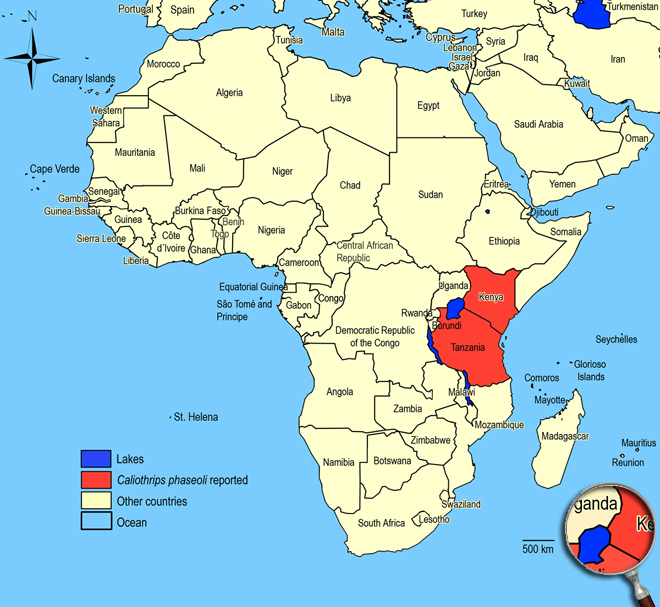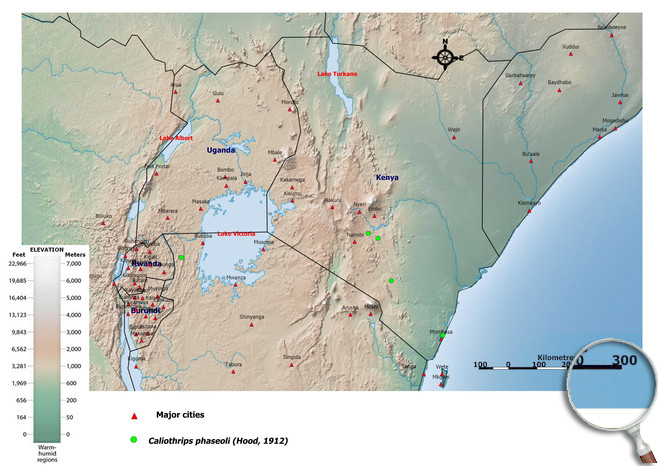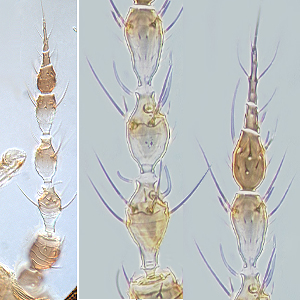Caliothrips phaseoli (Hood, 1912)
Panchaetothripinae, Thripidae, Terebrantia, Thysanoptera
Figures
Fig. 1: 8-segmented antenna, segments III and IV with forked sense cone, terminal segments V-VIII
Fig. 2: Head dorsal with ocellar triangle
Fig. 3: Pronotum
Fig. 4: Meso- and metanotum
Fig. 5: Meso- and metasternum with lyre-shaped furca
Fig. 6: Fore- and hind wing, distal area of fore wing
Fig. 7: Tergites III-V
Fig. 8: Lateral region of tergite III
Fig. 9: Tergites VIII and IX
Fig. 10: Tergites IX and X
Fig. 11: Sternite VII and base of ovipositor valves
Introduction and recognition
Caliothrips phaseoli particularly damage legumes, both as crops and as weeds, adults disperse over many other crops. Body dark brown; anterior margin of head yellowish; all tarsi and apices of tibiae yellow; antennae brown, segments III-V yellow but shaded brown in apical half; fore wings brown, with 3 transverse white bands sub-apically, medially and sub-basally, but median band sometimes not evident, extreme base and apex dark brown. Antennae 8-segmented; segments III & IV with forked sensorium (Fig. 1). Head not constricted at base (Fig. 2). Pronotum without long setae, mainly with transverse or irregular equiangular reticles and many markings within each reticle (Fig. 3). Metanotum irregularly reticulate; one pair of major setae near anterior margin (Fig. 4); metafurca elongate and lyre-shaped (Fig. 5). Mid and hind tarsi 1-segmented. Fore wing first vein close to or fused to costal vein; second vein with about 6 setae; costal cilia shorter than costal setae (Fig. 6). Tergites with distinctive sculpture on lateral thirds comprising transverse parallel lines of which the anterior lines bear few markings (Fig. 7 and 8); tergite VIII with craspedum medially, but tooth-like microtrichia laterally (Fig. 9); X with incomplete median split (Fig. 10). Sternites with transverse reticulation (Fig. 11).
Male with slender transverse glandular area on each of sternites III-VII; tergite IX with median pair of setae thorn-like.
Taxonomic identity
Species
Caliothrips phaseoli (Hood, 1912)
Taxonomic history
Caliothrips flavescentis de Santis, 1967
Hercothrips ipomoeae Moulton, 1932
Heliothrips gossypii Moulton, 1927
Heliothrips braziliensis Morgan, 1929
Hercothrips phaseoli Hood, 1927
Heliothrips fasciatus Pergande, 1920
Heliothrips phaseoli Hood, 1912
Common name
South American bean thrips
Present taxonomic position
Family: Thripidae Stephens, 1829
Subfamily: Panchaetothripinae Bagnall, 1912
Genus: Caliothrips Daniel, 1904
Genus description
The genus Caliothrips Daniel, 1904
The genus Caliothrips currently includes more than 20 species. Members of this genus are dark brown, head and pronotum with a heavy net-like sculpture and with internal markings inside each reticle. Head without neck and dorsal ridge. Fore wings banded (usually dark with pale areas) and antennae with 8 segments, and forked sense cone on antennal segments III & IV. Most of the species in this group are found living in grasses and legumes (Mound & Kibby 1998).
Species description
Typical key character states of Caliothrips phaseoli
Coloration and body sculpture
Body color: mainly brown to dark brown
Surface of head, pronotum and fore legs: with heavy, often polygonally reticulate sculpture
Sculptured reticles on head and pronotum: with internal sculptured markings
Antennae
Number of antennal segments: 8
Form of sense cones on antennal segment III and IV: emergent and forked on segment III and IV
Forked sense cone on antennal segment IV: extending to a point at least a third to base of segment V
Terminal antennal segments: VI-VIII forming a single unit
Head
Cheeks shape: without constriction posteriorly
Head - occipital ridge dorsally: absent
Head: not prolonged in front of compound eyes
Ocelli: present
Prothorax
Pronotal blotch or internal apodeme: absent
Pronotum shape: broadly rectangular
Pronotum surface: with longitudinal reticulate sculpture
Mesothorax
Mesonotum: with an incomplete median division
Metathorax
Metanotum with dominant sculptured triangle medially: absent
Shape of metathoracic furca: elongate and lyre-shaped
Wings
Fore and hind wings: present, more than half as long as abdomen (macropterous)
Fringe cilia arising: from sockets
Fore wing veins: present
Fore- and hind wing surface: covered with microtrichia
Fore wing extreme apex color: dark
Apex of fore wing: with prominent terminal setae
Fore wing anterior margin (costal vein): with setae and cilia but setae longer than cilia
Fore wing costal fringe cilia: arising at anterior margin of wing
Fore wing first vein: close to or fused to costal vein
Fore wing first vein setal row: incomplete, with setae not closely and uniformly spaced
Fore wing number of setae of second vein: 6
Fore wing second vein setal row: complete, setae uniformly spaced
Fore wing shape: mainly parallel sided or margins run continuously towards each other
Fore wing surface: not reticulate
Fringe cilia on posterior margin near apex: distinctly wavy (undulated)
Length of fore wing costal setae at middle of wing: longer than half of median wing width
Shape of fore wing apex: with mainly posterior margin curved to join anterior margin
Fore wings: alternating bands of dark and light
Legs
Color of fore tarsi: pale or yellow, sometimes apically shaded or brown
Mid and hind tarsi: with one segment
Abdomen
Sculpture of lateral thirds of tergites III to VI: with irregular, closely striate, transverse parallel lines with few markings only in anterior half
Tergites: without distinctive tergal sculpture forming a series of arches on the antecostal ridges
Tergite II: without numerous recurved claw-like microtrichia anterolaterally
Tergites III to VI sculpture on lateral thirds: comprising mainly transverse parallel lines
Tergites IV and V median setal pair: shorter than distance between their bases
Tergite VIII to X: without unusually long and stout setae
Tergite X: not tubular, longitudinally incomplete
Setae on abdominal tergite X: all setae slender

Similar or related species
Caliothrips phaseoli, Caliothrips sudanensis and Caliothrips graminicola - all of them have tergites with close striations on lateral thirds, but in Caliothrips phaseoli between the lines few markings are present in anterior half of each tergite, Caliothrips sudanensis without markings in between and Caliothrips graminicola with many markings between the lines. Furthermore, the pronotum of Caliothrips graminicola has always irregular longitudinal reticulations, in Caliothrips phaseoli and Caliothrips sudanensis the reticulations are in parts transverse. Tergites of other species (Caliothrips fasciatus and Caliothrips impurus) usually have polygonal reticulations and numerous internal wrinkles on lateral thirds. Caliothrips fasciatus is the only species of the genus sculptured on pronotum with mainly equiangular reticulations (other species with irregular longitudinal reticulations). Compared to Caliothrips sudanensis with pale extreme apex on fore wings, other species have a dark extreme apex on fore wings. In Caliothrips fasciatus and Caliothrips graminicola the forked sense cone on antennal segment IV scarcely extends beyond base of segment V, whereas in Caliothrips impurus, Caliothrips phaseoli and Caliothrips sudanensis the forked sense cone on antennal segment IV extending to a point at least a third to base of segment V.
Members of Caliothrips can be recognised by their reticulate sculpture that bears internal markings. Only Retithrips syriacus has also complex markings within each of the reticles, and fore wings bearing anteromarginally 3 curious blister-like callosities and minute setae. Compared to the closely related genera Hercinothrips and Selenothrips, the head of Caliothrips species is not constricted into a neck. Hercinothrips has 2-segmented tarsi (Caliothrips and Selenothrips have 1-segmented tarsi) and in Selenothrips the hind margin of tergite VIII has a complete comb of long teeth, the pronotum a transverse striate sculpture and the metanotum a dominant sculptured triangle medially (in Caliothrips and Hercinothrips tergite VIII posteromarginal comb of microtrichia only laterally, pronotum with reticulate sculpture, and metanotum without dominant sculptured triangle medially).
Biology
Life history
Probably similar to the longevity of Caliothrips fasciatus larvae ranging from 0-14 days and adults ranging from 7-15 days, both dependent on temperature (Lewis 1973).
Host plants
Crops: alfalfa, beans (soybean, snow pea), cotton, groundnut, sunflower, tomato.
Weeds: Asystesia mysoorensis, Clitoria sp., Senna bicapsularis.
Vector capacity
None identified, but possible mechanical distribution of phytopathogenic fungi and bacteria.
Damage and symptoms
-
Detection and control strategies
-
Additional notes
Apparently breeding only on the leaves of various legumes, and sometimes recorded as a pest of beans, but when populations are high the adults may be found on many other plants.
Biogeography
Central and South America, North America, East Africa. Kenya, Tanzania.
African countries where Caliothrips phaseoli has been reported

Occurence of Caliothrips phaseoli in East Africa

Please click here for survey sites of all observed thrips species of Kenya, Tanzania and Uganda.
Click here for locations of Caliothrips phaseoli in parts of East Africa.

Bibliography
Clinton PKS (1962). Causes of loss of yield in groundnuts in the Sudan central rainlands. Empire Journal of Experimental Agriculture. 30: 137-144
de Manero EA & de ľArgentier SM (1987). Aphididae y Thripidae per judiciales al cultivo de lenteja en la provincia de Jujuy. Revista de Investigacion Centro de Investigaciones para la Regulacion de Poblaciones de Organismos Nocivos. 5 (1-4): 17-26
de Santis L (1967). Dos nuevas especies de tisanopteros del Brasil. Comision de Investigacion Cientifica, La Plata. 4 (6): 1-6
Faure JC (1962). Thysanoptera of Africa - 7. Entomologisk Tidskrift. 83 (1-2): 4-43
Hood JD (1912). A new genus and three new species of North American Thysanoptera. Psyche. 19 (4): 113-118
Hood JD (1927). New neotropical Thysanoptera collected by C. B. Williams. II. Psyche. 34 (6): 230-246
Hood JD (1940). Two new Heliothripinae (Thysanoptera) from the Transvaal. Journal of the Entomological Society of Southern Africa. 3: 35-41
Lewis T (1973). Thrips: their biology, ecology and economic importance. Academic Press Inc., London Ltd., 349 pp
Lewis T (1997). Thrips as crop pests. CAB International, Wallingford, 740 pp
Mazza CA, Izaguirre MM, Zavala J, Scopel AL & Ballare CL (2002). Insect perception of ambient ultraviolet-B radiation. Ecology Letters. 5 (6): 722-726
Mazza CA, Zavala J, Scopel AL & Ballare CL (1999). Perception of solar UVB radiation by phytophagous insects: Behavioral responses and ecosystem implications. Proceedings of the National Academy of Sciences of the United States of America. 96 (3): 980-985
Mendes SM & Bueno VHP (2001). Biologia de Orius insidiosus (Say) (Hemiptera: Anthocoridae) alimentado com Caliothrips phaseoli (Hood) (Thysanoptera: Thripidae). Neotropical Entomology. 30 (3): 423-428
Morgan AC (1929). A new genus and five new species of Thysanoptera foreign to the United States. Proceedings of the Entomological Society of Washington. 31: 1-9
Moritz G (2006). Thripse. Pflanzensaftsaugende Insekten, Bd. 1, (1. Auflage). Westarp, Hohenwarsleben, 384 pp. ISBN-13: 978 3 89432 891 7
Moritz G, Morris DC & Mound LA (2001). ThripsID - Pest thrips of the world. ACIAR and CSIRO Publishing Collingwood, Victoria, Australia, CDROM ISBN 1 86320 296 X
Moritz G, Mound LA, Morris DC & Goldarazena A (2004). Pest thrips of the world - an identification and information system using molecular and microscopical methods. Centre for Biological Information Technology, University of Queensland, Australia, CDROM ISBN 1 86499 781 8
Moritz G, O'Donnell C & Parrella M (2009). Pest thrips of North America. Centre for Biological Information Technology, University of Queensland, Australia, CDROM ISBN-13: 978 1 86499 940 2
Moulton D (1927). Four new Californian Thysanoptera with notes on two other species. Pan-Pacific Entomologist. 4: 30-35
Moulton D (1932). The Thysanoptera of South America (1). Revista de Entomologia. 2 (4): 451-484
Mound LA & Kibby G (1998). Thysanoptera: An identification guide, (2nd edition). CAB International, Wallingford and New York, 70 pp
Mound LA & Marullo R (1996). The thrips of Central and South America: An introduction (Insecta: Thysanoptera). Memoirs on Entomology, International, Vol. 6. Associated Publishers, Gainesville, 487 pp
Palmer JM, Mound LA & Du Heaume GJ (1989). 2. Thysanoptera, 73 pp. In Betts CR [ed.], CIE Guides to insects of importance to man. CAB International, Wallingford, Oxon, UK
Viteri D, Cabrera I & Estévez de Jensen C (2009). New record of thrips species associated with soybeans in Puerto Rico. Florida Entomologist. 92 (1): 181-185
Wilson TH (1975). A monograph of the subfamily Panchaetothripinae (Thysanoptera: Thripidae). Memoirs of the American Entomological Institute. 23: 1-354
----
Web links
Mound´s Thysanoptera pages
Thysanoptera Checklist
ICIPE Thrips survey sites
UNI Halle & Thrips sites
Thrips of California















